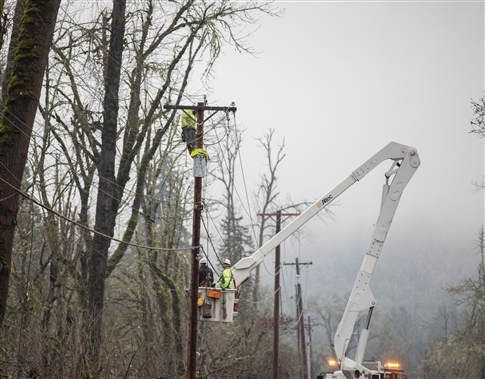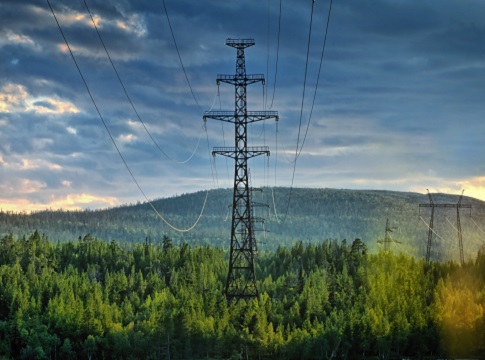Related News
Related News
-
EWEB reaffirms commitment to resilience with Wildfire Mitigation Plan approval
The utility is testing new equipment, leveraging technology, and incorporating third-party expertise to bolster electric system resiliency to a range of threats, including wildfire.
Find Out More -
Water professionals showcase skills in Cascade to Coast Competition
Representatives from local utilities competed to see who has the best-testing water, who can assemble a water meter the fastest and who find the most creative way to solve a routine problem that water utility professionals often face.
Find Out More -
Energy conservation could offset large portion of growth in power demand
Preliminary results of an EWEB study indicate that cutting back demand can contribute to maintaining a reliable, affordable energy supply.
Find Out More -
Groups suing EWEB will burden customers with litigation-driven costs
EWEB expresses disappointment that groups choose court over collaboration and firmly disputes the claims made in the lawsuit relating to operation of the utility’s Carmen-Smith Hydroelectric Project nearly 70 miles east of Eugene. EWEB takes its environmental and public safety responsibilities seriously. Contrary to the assertions in the lawsuit, construction of fish passage was postponed because EWEB’s regulator, the Federal Energy Regulatory Commission (FERC), required the utility to study and resolve urgent dam safety issues first.
Find Out More -
Small number of McKenzie Valley EWEB customers face higher February bills due to estimated reads
EWEB under-estimated energy usage for about one-fifth of upriver customers in December or January, resulting in higher true-up bills in February.
Find Out More -
EWEB offers Greenpower Grant to support local sustainability project
The Greenpower Grant, funded by voluntary customer subscriptions to Greenpower, not customer grants, supports projects that advance renewable energy, clean energy education or efforts to reduce or offset local carbon emissions.
Find Out More -
Rising Together: Female operation staffers begin industry mentorship program
One week into Women's History Month and just before International Women's Day on March 8, three women in EWEB leadership roles embarked on a 10-month-long journey of mentorship, fellowship, and professional development.
Find Out More -
EWEB and BRING cook up new ways to help Eugene businesses save energy
Businesses can cut energy costs with EWEB’s free Energy Assessments and efficiency programs. Plus, for a limited time, BRING is offering $1,000 rebates for qualifying upgrades—apply by Feb. 28!
Find Out More -
PNW Lineman Rodeo raises $85,000 for Oregon Burn Center
EWEB line techs are proud partners and participants in the rodeo fundraiser every year.
Find Out More -
EWEB customers and employees share the love through Energy Share donations
EWEB budgets funding to help customers struggling to pay their utility bill, but the need is always greater than what we can provide alone. Energy Share, our customer donation funded program helps fill the gap.
Find Out More -
Energy demand reaches highest level in nearly a decade as utility prepares for ice
Frigid temperatures in the low 20s caused surging electricity demand in early February.
Find Out More -
EWEB leverages Oregon Clean Fuels Program to support electric mobility
Five grants support programs benefiting homeless youth and bike sharing, among others.
Find Out More -
Frigid weather drives highest energy demand of the winter so far
Peak electricity demand this season surpasses demand levels during last year’s ice storm.
Find Out More -
Favorite Photos of 2024
Communications Specialist and "Resident EWEB Photographer" Adam Spencer shares his favorite photos - and the stories behind them - from a busy year of getting things done, being part of the community, and inspiring the next generation of stewards.
Find Out More -
EWEB awarded $1 million for wildfire resiliency projects from Federal funding package
Funds will be used to support fuels reduction work on a landscape scale in high-risk areas in the McKenzie River Valley and Eugene South Hills.
Find Out More - Show More
Recovery still ongoing on the anniversary of the 2024 Ice Storm
January 15, 2025 • Robyn Smith, EWEB Communications

Almost one year ago, a double-header ice storm plowed through the Pacific Northwest, wreaking havoc on electrical infrastructure across the region. The first storm hit on Jan. 13, and a second one rolled in on Jan. 16. One year on, the resulting devastation has cost the Eugene Water & Electric Board (EWEB) $9.4 million to clean up, including replacement of equipment and materials, staff time and contracted labor – and expenses continue to roll in.
Another major infrastructure project on a transmission line that is slated for this year will cost an additional $2 to $3 million, bringing the total to between $11.5 and $12.5 million. EWEB used its reserve fund to absorb the initial costs of responding to the ice storm but has applied for reimbursement from the Federal Emergency Management Agency (FEMA). The utility expects reimbursement for 75% of the total costs, with reimbursement money arriving in 2025.
The 2024 storm’s duration, community impact, cost and outage count were nearly double that of previous storms in 2016 and 2019, because of more severe weather. But EWEB was able to resolve more outages per day per EWEB worker in 2024 because of the utility’s investment in emergency response preparation over the past few years.
“The 2024 ice storm will go down in history as one of the most damaging events for our electrical system. For some it was an inconvenience and for others it was a devastating test from Mother Nature.” said EWEB Electric Division Manager Tyler Nice, the incident commander during the storm. “But it will also be remembered as a moment when our entire utility – and our entire community – came together to recover from a disaster. We were truly warmed on those icy days by the support from the community to keep up the restoration pace through all conditions.”
Damage from 2024 storm far exceeded other major storms in 2016 and 2019
The damage caused by the 2024 ice storm was unprecedented. During the storms, fallen trees blocked roads power poles toppled under the weight of the ice. Wires were snagged and snapped from the strain and transformers – which change, or “step down,” high voltage from power generation stations and high voltage transmission lines to levels that can be safely distributed to homes and businesses – were destroyed.
The storm took out power for a total of 38,000 customers, or more than one-third of EWEB’s customers. At the peak of the outages, 24,000 customers were without power at the same time. Some customers, particularly in heavily wooded areas in the lower McKenzie service territory, were without power for more than a week. EWEB crews worked 16-hour days for nearly two weeks to get power back online. Between line workers, logistics staff, safety staff and office personnel, 250 EWEB staff were solely dedicated to the emergency. During the storm, EWEB restored power for 97% of customers who lost it within seven days.
During and after the storm, EWEB replaced vast amounts of equipment: 352 poles and crossarms, 92,700 feet of wire and 84 transformers. The equipment EWEB replaced was approximately double that of the previous winter storms in 2016 and 2019. The devastation of the 2016 ice storm, which took out power for 23,000 customers, prompted EWEB to focus on emergency preparedness and disaster recovery. The goal after that storm was to improve customer trust and confidence during future disruptive events, such as large storms by modernizing restoration procedures to enable development of a public facing outage map and more streamlined field assessments and restoration.
Impacts felt across EWEB’s system in 2024
The storm impacted various parts of EWEB’s system. EWEB’s Walterville and Leaburg Hydroelectric Projects on the McKenzie River lost power at the start of the storm. To ensure that critical systems — including those for managing and monitoring water flows in the canals — kept running, EWEB drove emergency generators to the two sites.Early in the storm, falling trees took down the transmission line that links EWEB’s Carmen Smith Hydroelectric Project on the McKenzie River to Eugene, disconnecting it from the power grid. Without access to the grid, EWEB was unable to produce power valued at approximately $4.3 million, funds would have helped pay for operations and capital work for the utility. Perhaps the most nerve-wracking moment during the storm was when EWEB’s Hayden Bridge Water Filtration Plant lost all utility power three separate times between Jan. 14 and Jan. 18, forcing the plant to switch to emergency backup generators that EWEB had installed in 2020. A key task for EWEB’s logistics teams and fleet operators was refueling the diesel generator, navigating treacherous and icy roads to do so.
Heavy ice accumulation complicated the operation of the treatment plant’s intake gate, effluent gates, valves, filters and other equipment. EWEB staff manually opened and closed the gates to keep them unstuck. As the ice thawed, power outages, falling trees and blocked roads made one of the gates inoperable, forcing EWEB to implement a temporary fix that allowed for manual operation until crews could fully restore operation later.
Gravity pushes water from a series of base-level reservoirs on hills throughout Eugene to most of EWEB’s water system. But some neighborhoods are at elevations higher than the base-level reservoirs. Pump stations push water uphill to small storage reservoirs at these elevations. Where needed, EWEB kept pump stations operating using emergency generators. Only one station lost power temporarily.
After-action report emphasizes improving timely restoration updates to customers
After the storm, EWEB analyzed the successes and failures, generating a 26-page after-action report. One lesson was that customers in the McKenzie River Valley without power often have trouble accessing information online. Since the ice storm, EWEB has established a partnership with McKenzie Fire and Rescue (MFR) so that EWEB can send key information to MFR to print and display on paper at the Leaburg MFR office.
One key conclusion from the after-action report was that EWEB needs to improve tracking of outage assessments and restorations so customers can know when power will return to their home.
“The storm was an all-hands-on-deck moment, and every employee at EWEB stepped up to respond to outages quickly and get the power back on. Our people are truly our greatest asset,” Nice said. “Our main focus of improvement is ensuring our crews have what they need to restore, and ensuring we have reliable information around restoration times for customers amongst the chaos of initial damage.”
In particular, EWEB is improving internal processes to estimate when individual outages will be restored more accurately so customers can make plans accordingly.
“Crews were working at a safe but swift and focused pace, and sometimes the work itself outpaced the information about which customers we were restoring when,” Nice added. “We are working to ensure that restoration information flows as quick as the power to help customers who are making plans about staying in hotels or with friends and who are just wondering where they stand in the queue. It’s not feasible to give exact timing of restoration, but we can give estimates for folks to plan their lives.”
Read "Nine days without power: my ice storm story as an EWEB employee and customer"
Related Programs
Together, we prepare. Find information about preparing your household for an emergency.



